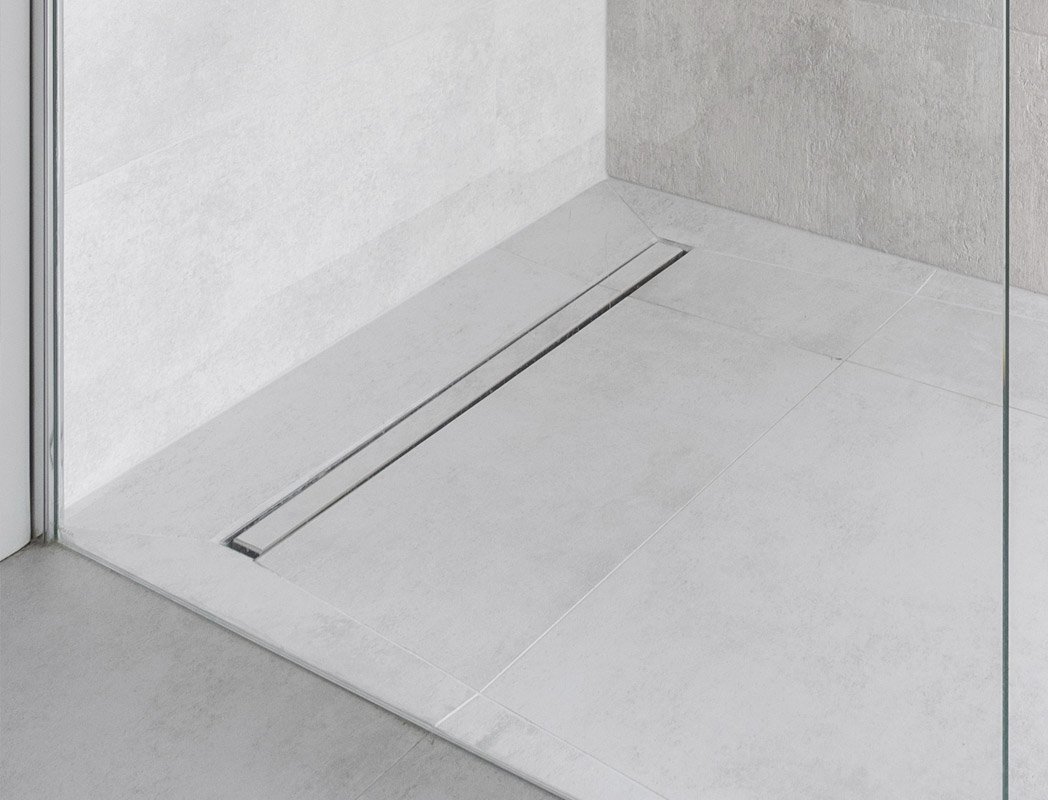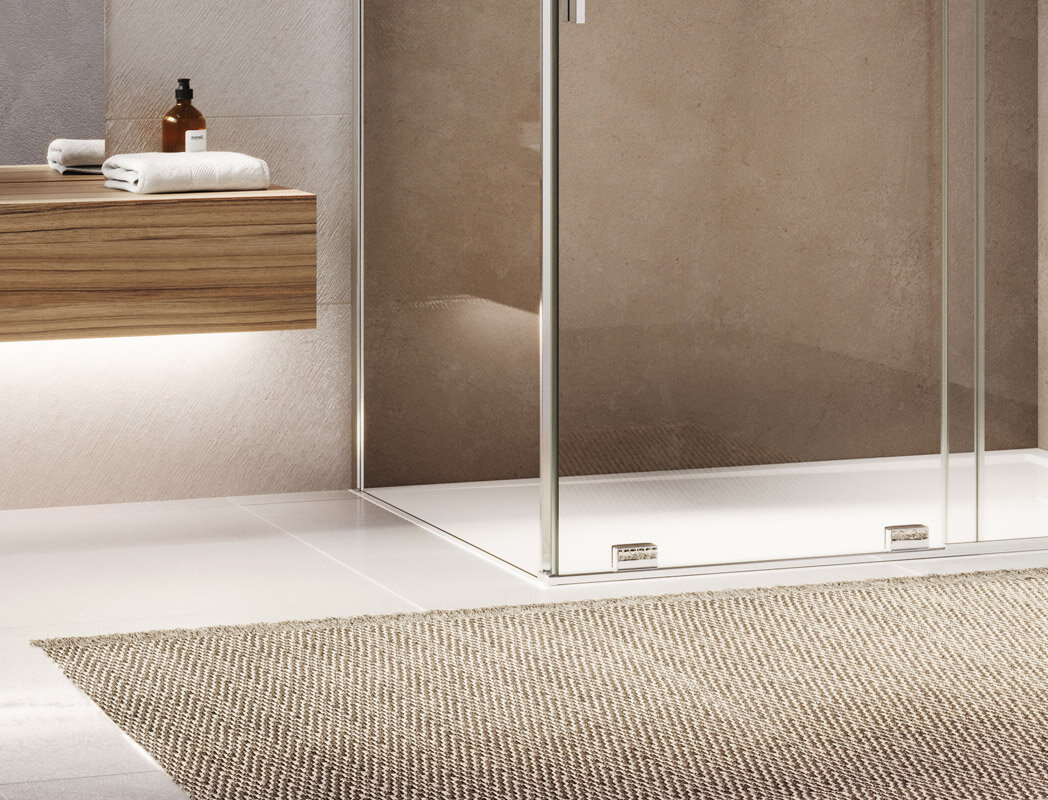Shower drain - which one to choose?
4 September 2023

Linear drain - what are its advantages?
The reason why a shower with linear drainage is so popular is the multitude of benefits that come with this solution. The first thing that makes it attractive is its unique aesthetics. In this case, less is more, because the drain is practically unnoticeable, unless the investor wishes otherwise. Then they can consider, for example, illuminated models. Most often, however, the floor inside the shower enclosure is the continuation of the bathroom floor - linear drainage allows us to lay tiles inside of the enclosure as well. This makes the shower unit less conspicuous and visually enlarges the bathroom. Investing in a linear drain also opens up new possibilities when planning the decor. With this option, the floor slopes only on one side, instead of four, as it is in the case of traditional drainage. This way, we don’t have to limit ourselves to laying small tiles only - those in larger sizes can also be used here. What’s more, the drain can be located anywhere - at the back wall of the shower unit, on the sides, at the exit - which also increases our design possibilities.
A linear shower drain is not only about aesthetics, but also practicality and comfort. With its design, a linear drain is able to collect more water than a point drain. It is therefore more hygienic and efficient. With linear drainage, there’s no difference in floor level. Since you don’t have to lift your legs to enter the shower tray, convenience and safety are increased. The risk of slipping and falling is smaller. Knowing the basic advantages, we can answer the basic question that investors ask themselves: linear drain - which one to choose?

Linear drain - what to look at?
Looking through offers of different stores, it’s easy to see that a linear shower drain is available in many versions. Most often we can purchase a prepared set consisting of a channel, trap, strip and the components needed for installation. However, they will vary in terms of technical parameters, so before buying it, take a moment to think. Besides, even if a linear drain model meets the basic conditions needed to install it in our bathroom, there’s the matter of cleaning and its finish. Easy cleaning translates into convenience of use, as maintaining cleanliness doesn’t require a lot of time. The finish, on the other hand, affects the presentation and whether the drain blends well with the overall decor of the bathroom. So, what to look at and which linear drain to choose?
Capacity of the linear drain
The first thing that should interest the buyer is the capacity of the device. It determines how much water goes into the drain in one minute. The level of capacity depends on what kind of trap is used in the device. The minimum value is considered to be 24 l/min, while with the highest quality models the value can exceed 90 l/min. This doesn’t mean we immediately need to focus on drains with upper-limit capacity. It should be chosen depending on the effectiveness of our shower faucet.
Trap height
One of the basic matters is the height of the trap. Most often it oscillates between 10 and 15 cm. The optimal height depends on the bathroom in which the linear shower drain will be installed. For places where the floor layer is low, for example, in a block of flats, the trap should be low. It happens though that the standard height is too high, but fortunately, manufacturers also offer low models, where the entire installation doesn’t exceed 6-7 cm.
Linear drain size
The linear shower drain can have a different size depending on how large the shower unit is. It’s recommended that its length be around 10 cm shorter than the width of the enclosure. This means that if its width is 100 cm, the ideal drain will have 90 cm. If the enclosure is smaller, and its width is 80 cm, then we should look at 70 cm drains.
Linear drain design
Although the linear drain is subtle and doesn’t attract attention, its appearance can be matched to the character of the bathroom. After we have verified which models are suitable in terms of technical parameters, it’s worth taking another look at them from the point of view of our bathroom design.
We can opt for a model with a tile insert or a grate, which linear drain should we choose? The first type is a tiled shower gutter. It will be a good option if we wish the drain visually blended with the floor. Here we adhere bathroom tiles onto the grate. The disadvantage of this solution is a lower water flow. More popular is the second option, in which the drain ends with a grille. Grilles are available in different shades and are finished in interesting patterns. They look elegant and stylish, and at the same time do not reduce the flow capacity. In most cases, the grille can be easily removed and cleaned, and some models also have a removable trap.
Quality of the linear drain
A linear drain is a long-term investment. This means that we shouldn’t limit ourselves to choosing models that seem attractive due to their price. Quality also matters. Thus, it is worth focusing on those ones from respected manufacturers who ensure the drains are made of durable materials. Also, some of them provide extended warranty, which is also an asset.
The materials used must be resistant to damage and corrosion. For example, aluminum or stainless steel will work well. The linear drain set should include stable adjustable height legs. Besides, it’s better to opt for a set with higher number of legs, as this will provide better stability. When shopping, we should also look at the sealing elements and joints. There should be no gaps since the linear drain is in frequent contact with water and moisture.
Linear drain or a shower tray after all?
Installing a linear drain isn’t possible in every building - it depends on the thickness of the floor. Although in the end a shower completed with a linear drain looks simple and minimalist, before its installation, a series of time-consuming works are required, which aren’t needed with shower trays. Hammering the floor, preparing the slope that protects from flooding and good hydro-insulation are essential. It’s best to hire a professional, who will ensure that the installation is done correctly. All this together makes the renovation long and much more costly than it is in the case of a shower tray.
If you’re dreaming of a minimalist shower unit, instead of linear drainage you can consider ultra-slim shower trays from SanSwiss. They are much lower than most solutions available on the market and can be successfully installed instead of a linear drain. Additionally shower tray could be flushed with floor to maintain the same level between tray and floor tiles. But the biggest advantage of the trays is ease of cleaning (no grout ant joints on the surface of the floor) and 100% confidence that it will never leak. This investment will be cheaper, faster and can be applied in any bathroom.
If a linear shower drain is impossible or difficult to install, and the investors don’t want to have a tray with their shower enclosure because they’re dreaming of a walk-in shower, an interesting solution would be, for example, a wall drain. It’s important that it has a removable trap and is suitable for heavy and light plasterboard installation. This will give a uniform floor surface, and the tiles will reach up to the wall. Some manufacturers of this category devices offer additional LED lighting, which makes the shower enclosure look even more unique.
